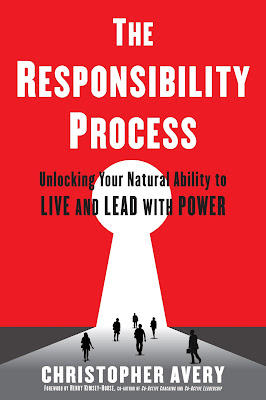Christopher
Avery was known as “The Responsibility Process® guy” long before he wrote his
long-awaited book titled The
Responsibility Process: Unlocking Your Natural Ability to Live and Lead with
Power.
 In the early 1990s, having earned
his doctorate in organizational communication, Christopher’s interest in shared
responsibility and improving teamwork in high-impact cultures introduced him to
the framework that eventually became his life’s passion. Nonetheless, it took
him a while to permanently chronicle his groundbreaking work. He co-founded
Partnerwerks in 1991 to share best practices for collaborating under
competitive conditions and published his first book, Teamwork Is an Individual Skill, in 2001. All the while, his
obsession with personal responsibility continued to grow.
In the early 1990s, having earned
his doctorate in organizational communication, Christopher’s interest in shared
responsibility and improving teamwork in high-impact cultures introduced him to
the framework that eventually became his life’s passion. Nonetheless, it took
him a while to permanently chronicle his groundbreaking work. He co-founded
Partnerwerks in 1991 to share best practices for collaborating under
competitive conditions and published his first book, Teamwork Is an Individual Skill, in 2001. All the while, his
obsession with personal responsibility continued to grow.
The
thing was, virtually everyone knew that taking personal responsibility was the
first principle of success, but no one could tell you how to do it, or how to
avoid the pitfalls so frequently encountered – only that you should take personal responsibility. With
hard-earned experience in both eluding and taking personal responsibility,
Christopher turned his attention from collaboration to understanding how
personal responsibility actually works in the mind. He joined a team
investigating the natural mental pattern that helps people process thoughts
about taking or avoiding responsibility and then built the knowledge and
systems to help them master personal responsibility in literally any context.
For
the next decade, Christopher consulted with companies, gave keynote addresses,
and wrote about personal responsibility, helping people activate their innate
leadership ability with precision tools, practices, and leadership truths, but
he still didn’t write a book. He laughs, “I was constantly asked when I was
going to write a book on The Responsibility Process. I knew I should
permanently document this material, but until last year, I didn’t feel ready to
do so.”
By
2015, with his clients steadily clamoring for this amazing material to be
documented, Christopher was ready. He organized his material and got to work. The Responsibility Process: Unlocking Your
Natural Ability to Live and Lead with Power was published in October of
2016.
Christopher realizes he went
about the book publishing process a bit differently from how most people
approach it. He explains, “Usually people have some type of expertise, and then
they write a book and begin speaking about it. I did it backwards. I talked
about The Responsibility Process for ten or fifteen years before I wrote the book. I am constantly introducing
people/audiences to The Responsibility Process. I’m sort of a one-trick pony; I
keep presenting it over and over.”
Christopher
wasn’t interested in selling his book to a major publisher. On the contrary, he
wanted the control and leverage self-publishing gave him. His highest priority
once he decided to write the book was to put out a quality product in all ways,
from highly polished content to a sophisticated cover to the finished book
itself. He comments, “I wanted the final product to be worth the subject
matter.” Because the self-publishing landscape is so fragmented, he didn’t feel
he could manage all the parts himself. Instead, he sought out a top-notch book
publishing firm. He admits, “It was too big of a learning curve for me to
manage on my own.”
Since the book’s release,
Christopher has been focused on steadily promoting it through a series of blog
posts, guest blogging on other peoples’ blogs, and keynote speaking engagements
that have proven to be a highly effective method of selling the book. In fact,
the first 650 copies went to participants at a conference in Munich Christopher
was asked to keynote after the organizers ordered a copy for every participant.
Likewise, for an upcoming keynote in Dallas, the organizers are supplying a
copy of the book to the first 200 people who sign up.
Tellingly,
Christopher has no advice for first-time book authors. He believes emphatically
that effective leadership starts with self, and The Responsibility Process
taught him not to give advice. He explains, “When you tell other people what
they should do, by putting you in a position of authority, they stop thinking
for themselves.”
Nonetheless,
he notes that when he wrote his first book, he didn't spend much time thinking
about how he would recoup the value of the investment he was making. With his
new book, he’s spent a lot of time positioning himself as a speaker and of
building a brand around the book and its title. He’s even looking at rebranding
his business around The Responsibility Process, eliminating his personal
website and using the name of the book as the website instead. He asks, “In a
world of brand building, do I need to build a brand around the corporate name?
I think the answer is no.”
The
Responsibility Process may indeed be “evergreen,” to quote Christopher, and
it’s also prolific – organizing his material helped him realize he had more
tools than he needed or wanted to use in a single book. Today, he envisions a
whole series as an outgrowth of The Responsibility Process.
Now that’s going the distance,
one-trick pony or not.





